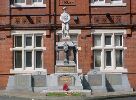
Newton-le-Willows and
Earlestown War Memorial

| OTHER WARS |
 |
Newton-le-Willows andEarlestown War Memorial |
 |
| The
Great War Roll of Honour |
|||||||||||||||||||||||||
Peter Tucker compares these two giants of the comic postcard scene
(Originally published in Picture Postcard Annual 1996)
(Reproduced by kind permission.)
From very early in the history of British picture postcards there have been comic cards drawn by artists, many of whom were excellent cartoonists, skilful watercolourists and draughtsmen. Phil May, Tom Browne, Dudley Buxton, Lawson Wood; the list goes on. But there are two artists that stand head and shoulders above the rest, (although they were only average height) both in sheer volume of work and artistic ability. Their names are Donald McGi11 and Douglas Tempest. Many of the other artists worked only part-time for postcards whereas both Tempest and McGi11 devoted their lives to them. Donald McGi11 became world-renowned for his sea-side comics and Douglas Tempest as champion of the working classes. McGill's introduction into comic postcards pre-dates Tempest's by eight years, and he was also twelve years older, but apart from this both men had much in common. They had taken up other careers before turning to postcard design, and by all accounts were honest, quiet, unassuming gentlemen, with the emphasis on gentle. Both had a sense of humour and a talent for art, rare gifts which they were able to express through the medium of comic postcards. McGi11 began designing comic cards in 1905 and Tempest in 1912.
By August 1914, when Great Britain declared war on Germany, Donald McGi11 was 39 years old and Douglas Tempest 27. Neither were eligible for the armed forces: McGill was disabled, having lost a foot in a freak accident while playing rugby when he was sixteen, and Tempest had a heart defect. Both men resigned themselves to the fact and settled down to what they could do best, make people laugh. The importance of comic postcards for this period cannot be understated. At worst they were a valuable means of communication between serving men and loved ones, at best they helped lighten the discomforts and horrors of the war. McGill's war cards were published by Inter-Art and he worked from his home in Blackheath, Kent. Tempest was the staff artist for Bamforth Go. Ltd., working in their studio at Holmfirth, West Yorkshire. Although of Scottish ancestry, McGill had become very much a southerner, without losing his roots, whereas Tempest, who in fact was born in Norfolk, was as much a northerner, and these geographical differences were at times reflected in their work.
The aim of this article is to compare the works of these two great illustrators through the comic cards they produced during World War 1. By using the messages written on the backs, where appropriate, and outlining the events of the war, I hope to explain the contents of these fascinating designs. The focus the war gave them arguably inspired their best work.
Other chapters:
Chapter 7 Conscription, Conscientious Objectors and New Recruits